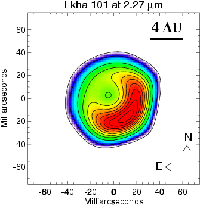
 |
What's New at the CfA |
![[CfA Home]](030201_files/cfa-home.gif)
![[CfA Search]](030201_files/cfa-search.gif)
![[CfA Help]](030201_files/cfa-contact.gif)
|
|
|
Young Star Caught Eating DoughnutTechniques of optical interferometry have been used to harness the full diffraction-limited power of the Keck-I telescope to image an accretion disk around young stellar object with unprecedented clarity. Peter Tuthill (University of Sydney), John Monnier (Harvard-Smithsonian Center for Astrophysics), and Bill Danchi (NASA - Goddard Space Flight Center) present the first resolved image of near-infrared emission from the inner edge of an accretion disk in a letter to Nature (February 22, 2001). These observations were made possible through an innovative "aperture masking" experiment to convert the 10-m primary mirror of Keck into a VLA-style interferometric array. While some astronomers might be disturbed at the prospect of "throwing away" more than 90% of the incident light, this technique allows vastly improved calibration of atmospheric turbulence, essential for reliable image reconstructions at the finest angular scales.
The depression, or hole, of emission at the center of the ring occurs because the dust in the accretion disk evaporates when it gets too close to the hot young star, which is drawing material from the disk inwards through gravity. The existence of such a dust-free cavity has been predicted, but never before directly imaged. Importantly though, the size of this cavity here is much larger, by a factor of 5 to 10 times, than that predicted by classical accretion disk models. A recent survey of near-IR emission from other Herbig Ae/Be stars (http://cfa-www.harvard.edu/cfa/oir/IOTA/PUBLI/PDF/Millan-Gabet2001.pdf) carried out by the Infrared Optical Telescope Array (IOTA) also concluded that theoretical models under-estimated the true near-infrared sizes of these sources. With a new third-telescope being commissioned later this year, IOTA will be able to extend these results to image the emission around additional sources with approximately four times better spatial resolution than Keck, in order to indicate the presence, or absence, of flattened disks and determine their characteristic sizes. More information on this discovery, including a preprint of the aforementioned Letter, can be found at the following website: http://cfa-www.harvard.edu/~jmonnier/Lkha101 A copy of the NASA-Goddard Space Flight Center News Release is available at: http://www.gsfc.nasa.gov/GSFC/SpaceSci/origins/dustdonut.htm
|
(To submit ideas for future editions of "What's New at the CfA," please send email to pubaffairs@cfa.harvard.edu.)
